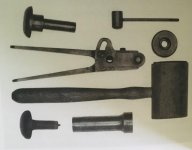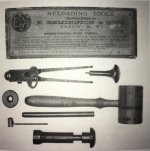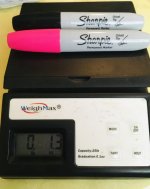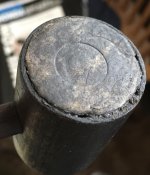Many hours spent researching this subject. I've found so much info that it's hard to summarize.
I am convinced now that Smith & Wesson and Remington DID NOT manufacture the actual tools contained in these kits. What I could not confirm is what cartridge reloading tool manufacturer/vendor actually did.
Quite often when you research the old Gun manufacturers you will find that they occasionally sub-contracted parts manufacture to another firm. The problem being locating who in fact that firm was. More often it seems that they had no problem putting their company name on a product that was basically manufactured by another vendor (Remington?). So we remain in the dark never knowing that the basic product was in fact made somewhere else and the final product actually assembled or "put together" in a kit & boxed by the Gun Manufacturer. Many examples exist and are documented.( Too long a list for this thread)
The earliest listing for the tool kits I found in my Distributor collection is from the 1877 Remington full early catalog listing the .38 S&W and .44 Russian reloading components. This makes sense since the .32 was not introduced until 1878. The next listing in line was in the 1880 Homer Fisher( New York). This early listing is "IDENTICAL" to the 1883 listing in M. Robinson (New York) listing the S&W kits.
Also the photo of the tools is the same as listed by Smith & Wesson( Springfield, Mass) in their 1887 catalog. I also found the tool kit listed in Hibbard, Spencer & Bartlett & Co(Chicago) in their 1884 catalog for all 3 Smith & Wesson calibers.
When we cross reference the time frame( In the industry as a whole) we see a large volume of reloading boxed kits hitting the market in the 1881-1882 timeframe. Here is a very basic list:
1873-Earliest kits were straight line loaders for rifles by Maynard, Pickers, Marlin, Frankford Arsenal, Frank Wesson. etc
1874-Winchester field loader and later bullet mold in various calibers. Improved in 1875, 1880,1882, 1891, 1894. Huge success in the two tool kits. (Loader, bullet mold, and primer punch, boxed)
1875- Remington kits
1876- Smith & Wesson kits (Baby Russian) No evidence of a 44 American kit but the 44 Russian may have worked for both?
1877- Marlin straight line loader (primarily rifles)
1881-Marlin field loader (Primarily rifles)
1882- BGI (Bridgeport Gun Implements)
1882- U.S. Cartridge Co.
1882- U.M.C. Union Metallic Arms Co.
1884- Whitney
All of these kits have similarities but the 3 kits that are way beyond similar is the UMC, Remington, & Smith and Wesson kits.
These 3 kits contain parts that are identical. This strongly suggest that there was a vendor making the parts and the kits were basically assembled by the final product manufacturer?
Besides the dies, the key component is actually "The Mallet". This feather weight wooden part is identical in all 3 of the early kits. I say early because I have documented enough of the kits to see a transition in manufacture to improve the parts.
Primarily, the Wooden plunger was replaced with steel and the early Mallet (that was prone to snapping about 1" behind the head) was beefed up at that location to avoid breakage. I actually documented multiple repairs made at that location with copper rings etc. Changes and minor differences in the bullet molds can easily be attributed to early and late production and that is exactly what this survey attributes the differences to represent.
So, the real mystery here is Who the vendor was that was supplying all of these firms with the parts.
See photo's of early Mallets in the UMC kit, Early Smith and Wesson kit, and Early Remington kit. Then later Mallet in last two photos.
Also, I believe the early boxed kits were available in 1876 with the introduction of the Baby Russian and basically became surplus with the Market swing to the field type one piece loaders introduced by Winchester and Ideal. Both companies basically captured the Market from that point on. About circa 1882-1884.
Any kits listed for sale after that timeframe represented Surplus Stock. So these kits were manufactured for a short period and are very scarce to rare from any manufacturer listed.
Murph
I am convinced now that Smith & Wesson and Remington DID NOT manufacture the actual tools contained in these kits. What I could not confirm is what cartridge reloading tool manufacturer/vendor actually did.
Quite often when you research the old Gun manufacturers you will find that they occasionally sub-contracted parts manufacture to another firm. The problem being locating who in fact that firm was. More often it seems that they had no problem putting their company name on a product that was basically manufactured by another vendor (Remington?). So we remain in the dark never knowing that the basic product was in fact made somewhere else and the final product actually assembled or "put together" in a kit & boxed by the Gun Manufacturer. Many examples exist and are documented.( Too long a list for this thread)
The earliest listing for the tool kits I found in my Distributor collection is from the 1877 Remington full early catalog listing the .38 S&W and .44 Russian reloading components. This makes sense since the .32 was not introduced until 1878. The next listing in line was in the 1880 Homer Fisher( New York). This early listing is "IDENTICAL" to the 1883 listing in M. Robinson (New York) listing the S&W kits.
Also the photo of the tools is the same as listed by Smith & Wesson( Springfield, Mass) in their 1887 catalog. I also found the tool kit listed in Hibbard, Spencer & Bartlett & Co(Chicago) in their 1884 catalog for all 3 Smith & Wesson calibers.
When we cross reference the time frame( In the industry as a whole) we see a large volume of reloading boxed kits hitting the market in the 1881-1882 timeframe. Here is a very basic list:
1873-Earliest kits were straight line loaders for rifles by Maynard, Pickers, Marlin, Frankford Arsenal, Frank Wesson. etc
1874-Winchester field loader and later bullet mold in various calibers. Improved in 1875, 1880,1882, 1891, 1894. Huge success in the two tool kits. (Loader, bullet mold, and primer punch, boxed)
1875- Remington kits
1876- Smith & Wesson kits (Baby Russian) No evidence of a 44 American kit but the 44 Russian may have worked for both?
1877- Marlin straight line loader (primarily rifles)
1881-Marlin field loader (Primarily rifles)
1882- BGI (Bridgeport Gun Implements)
1882- U.S. Cartridge Co.
1882- U.M.C. Union Metallic Arms Co.
1884- Whitney
All of these kits have similarities but the 3 kits that are way beyond similar is the UMC, Remington, & Smith and Wesson kits.
These 3 kits contain parts that are identical. This strongly suggest that there was a vendor making the parts and the kits were basically assembled by the final product manufacturer?
Besides the dies, the key component is actually "The Mallet". This feather weight wooden part is identical in all 3 of the early kits. I say early because I have documented enough of the kits to see a transition in manufacture to improve the parts.
Primarily, the Wooden plunger was replaced with steel and the early Mallet (that was prone to snapping about 1" behind the head) was beefed up at that location to avoid breakage. I actually documented multiple repairs made at that location with copper rings etc. Changes and minor differences in the bullet molds can easily be attributed to early and late production and that is exactly what this survey attributes the differences to represent.
So, the real mystery here is Who the vendor was that was supplying all of these firms with the parts.
See photo's of early Mallets in the UMC kit, Early Smith and Wesson kit, and Early Remington kit. Then later Mallet in last two photos.
Also, I believe the early boxed kits were available in 1876 with the introduction of the Baby Russian and basically became surplus with the Market swing to the field type one piece loaders introduced by Winchester and Ideal. Both companies basically captured the Market from that point on. About circa 1882-1884.
Any kits listed for sale after that timeframe represented Surplus Stock. So these kits were manufactured for a short period and are very scarce to rare from any manufacturer listed.
Murph
Attachments
-
 63BF2040-52E2-49BA-BD35-1E3DD80E538F.jpeg97.2 KB · Views: 66
63BF2040-52E2-49BA-BD35-1E3DD80E538F.jpeg97.2 KB · Views: 66 -
 1BB08347-E666-418E-9305-73EDB1B0948A.jpg40.2 KB · Views: 55
1BB08347-E666-418E-9305-73EDB1B0948A.jpg40.2 KB · Views: 55 -
 D1909807-90EA-4C9C-B157-EEB735E4E8F6.jpeg158.8 KB · Views: 53
D1909807-90EA-4C9C-B157-EEB735E4E8F6.jpeg158.8 KB · Views: 53 -
 BE21716D-6AD0-463F-AD83-F96EE65D986C.jpeg92.6 KB · Views: 49
BE21716D-6AD0-463F-AD83-F96EE65D986C.jpeg92.6 KB · Views: 49 -
 E1CC3C78-086C-4B43-AD7F-299183C03DF9.jpg97.9 KB · Views: 49
E1CC3C78-086C-4B43-AD7F-299183C03DF9.jpg97.9 KB · Views: 49
Last edited:





